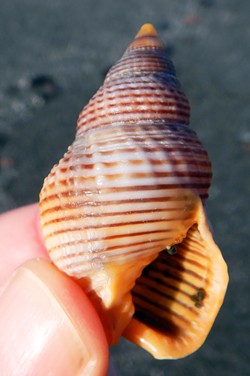[
{
"name": "Top Stories Video Pair",
"insertPoint": "7",
"component": "17087298",
"parentWrapperClass": "fdn-ads-inline-content-block",
"requiredCountToDisplay": "1"
}
]
I just gave some cruise ship passengers a tour called The Humboldt Culture and Beachcombing Experience. The first question from my busload of cruisers was: "Are you serving rum punch?"
I said, "No. This isn't the Caribbean. Our first stop is the Arcata Plaza, where I encourage you to experience our culture by mingling with locals and sampling our local delicacies and libations. Plus, there's a liquor store."
After herding them back onto the bus, one fellow held up a baggie and said, "A nice young man sold me these local delicacies. They are chewy and taste a bit earthy, but they go great with rum punch!"
So, on the way to the beach, my cruisers passed around the delicacy baggie and bottles of rum and punch.
I lost control of the group at the beach but I caught up with one old gal who was examining something. She said, "Oh wow ... it's so shiny and orange on the inside. It's the orangest thing in the world!"
I said, "Nice find! It's the shell of the giant western nassa snail, Nassarius fossatus, which is in the whelk family. Your specimen, with its 2-inch-high spire and inch-wide base, is about as big as they get. Your snail is also called a dogwhelk, a channeled nassa or even a basket snail because it has the bumpy texture of a spirally woven basket."
I heard a fellow screaming. He was cowering from an unseen monster or something. He was in a panic but, unfortunately, he did not have the defenses of a nassa snail.
I said, "When threatened, the nassa snail retreats into its shell and closes the door with a strong, flexible lid called an operculum."
I looked up to see one of my cruisers on her knees sobbing and eating sand by the fistful.
I continued, "The nassa snail eats mostly dead animal material, which it can sniff out from a distance using its long proboscis. It uses its raspy tongue to lick up the flesh. It can also use its tongue to bore through the shells of clams and lick their flesh out."
I glanced up at the surf to see an adorable nude couple laughing hysterically while trying to catch fish using their undergarments as nets.
"Ah yes," I said. "The nassa snail's Latin name means 'someone who digs and also uses a wicker basket to catch fish.' I think a silly snail biologist got a little carried away when naming it!"
She said, "Yes, nothing good ever happens when biologists try to be funny."
"Agreed," I said. Then I noticed a gentleman lying on his back working vigorously to – I don't know — inseminate the sun? He did create a beautiful one-winged sand angel though.
I continued, "Unlike many other mollusks, the giant western nassa snail has separate sexes. The male inseminates the female and then she lays egg capsules in strings up to 2.5 inches long. The snails normally live on mud or sand bottoms, but they lay their eggs on solid objects — from rocks to crab traps. The flat egg capsules are oval and leathery with soft little spikes around each edge. A string may contain 40 capsules and each capsule contains hundreds of eggs. The strings of hatched-out cases sometimes wash up in large quantities."
Then I saw one old guy happily buried up to his neck in the sand until another guy kicked his head as if he thought it was a soccer ball.
That's all I could take, so I hitchhiked home. Does anyone know if my cruisers made it back?
Biologist Mike Kelly (he/him) also writes science-based satire as M. Sid Kelly. It's available at Eureka Books or everywhere e-books are sold.
more from the author
-
Hot Tomcod Action
- Apr 18, 2024
-
Wandering Meatloaf
- Mar 7, 2024
-
Sea Palm Crime
- Jan 11, 2024
- More »

































